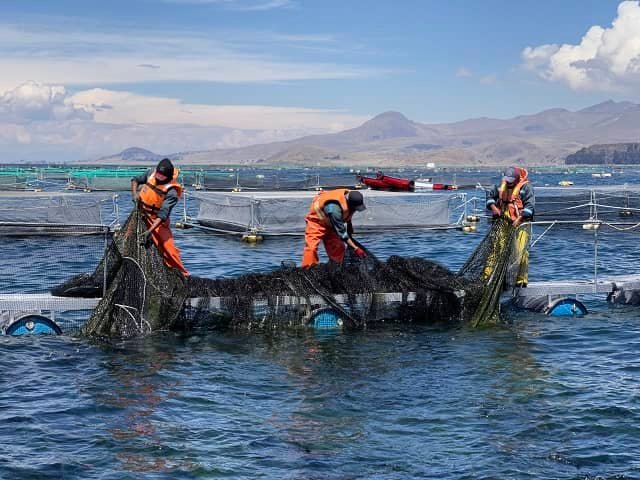
In the ever-evolving world of aquaculture, reducing dependence on fish meal and oil is a top priority. Sustainable alternatives are crucial, and a promising option is soy protein concentrate (SPC). But can fish efficiently digest and utilize this plant-based protein?
A recent study with rainbow trout (Oncorhynchus mykiss) conducted by scientists from the University of Vigo and Lucta S.A. sheds light on this issue, exploring the role of taste in optimizing digestion with SPC. Researchers compared three diets: high fish meal (HF), high SPC (LF), and LF enriched with a umami flavor-enhancing additive (LFU).
SPC: A Sustainable Solution with Challenges
Plant proteins like soy offer a sustainable and cost-effective alternative to traditional fish meal. However, their inclusion comes with challenges. Soy’s antinutritional factors can hinder digestion and nutrient absorption, potentially affecting fish growth and feed intake.
In this context, soy protein concentrate (SPC), with lower levels of antinutritional factors, emerges as a more potent alternative.
Food intake is a crucial factor in fish growth and performance. The impact of SPC on hormones and neuropeptides regulating appetite is under scrutiny. Studying these factors, such as ghrelin (a hunger hormone) and leptin (a satiety hormone), can reveal how SPC influences a fish’s feeding desire.
Umami: Enhancing Palatability with Taste
Palatability plays a significant role in food consumption. The study explored the potential of adding umami flavor-enhancing substances to SPC-based diets.
Umami receptors, present in fish intestines, can be activated by certain amino acids and nucleotides, potentially improving diet appeal and encouraging higher food intake. This makes food additives an important alternative to enhance the palatability of aquaculture feeds.
Key Results
The regulation of food assimilation in fish depends on different neuroendocrine and metabolic mechanisms; however, there is little information regarding the impact of diets on these mechanisms.
Researchers implemented one of the diets with a sensory additive (LFU diet) containing amino acids, nucleotides, and peptides known to activate umami taste receptors in vertebrates.
Interestingly, all groups consumed similar amounts of food. However, the LFU group showed a notable increase in digestive performance, highlighting:
- Better nutrient absorption: The digestibility of proteins, dry matter, and energy increased, suggesting better utilization of SPC nutrients.
- Faster amino acid absorption: Amino acid levels in the blood plasma peaked earlier in the LFU group, indicating efficient processing and transfer of key components.
- Activation of gut-brain coordination: Gene expression analysis revealed higher activity of amino acid transporters, taste receptors, and signaling molecules in the digestive tract and brain, suggesting strengthened communication between the gut and brain regarding nutrient availability.
“Based on these results, it is reasonable to assume that the LFU diet presence of free amino acids and small peptides capable of stimulating T1r taste receptors (umami and/or ‘sweet’ homologs),” the scientists report.
Impact on the Aquaculture Industry
The findings of this study extend beyond rainbow trout. The research paves the way for interesting possibilities:
- More sustainable feeds: By improving the utilization of plant proteins like SPC, dependence on fish meal can be reduced.
- Personalized dietary strategies: Understanding how taste modulates digestion opens doors to designing foods that are both appealing and nutritionally efficient.
- Better fish health and performance: Improved nutrient absorption translates to healthier fish and potentially higher yields.
Conclusion
The study results demonstrate that including umami receptor enhancers in the diet has the potential to improve fish physiological responses to increased levels of plant protein in the diet.
This research paves the way for a future where SPC plays a crucial role in aquaculture thanks to the use of feed enhancers. By optimizing diets and harnessing the power of taste, we can create a more sustainable and efficient industry, ultimately benefiting both fish and consumers.
The study was funded by Lucta S.A. and a research grant from the Xunta de Galicia.
Contact
José L. Soengas
Laboratorio de Fisioloxía Animal, Facultade de Bioloxía, Universidade de Vigo
36310 Vigo, Spain.
Email: jsoengas@uvigo.gal
Reference (open access)
Calo, J., Comesaña, S., Fernández-Maestú, C., Blanco, A. M., Morais, S., & Soengas, J. L. (2024). Impact of feeding diets with enhanced vegetable protein content and presence of umami taste-stimulating additive on gastrointestinal amino acid sensing and feed intake regulation in rainbow trout. Aquaculture, 579, 740251.
Editor at the digital magazine AquaHoy. He holds a degree in Aquaculture Biology from the National University of Santa (UNS) and a Master’s degree in Science and Innovation Management from the Polytechnic University of Valencia, with postgraduate diplomas in Business Innovation and Innovation Management. He possesses extensive experience in the aquaculture and fisheries sector, having led the Fisheries Innovation Unit of the National Program for Innovation in Fisheries and Aquaculture (PNIPA). He has served as a senior consultant in technology watch, an innovation project formulator and advisor, and a lecturer at UNS. He is a member of the Peruvian College of Biologists and was recognized by the World Aquaculture Society (WAS) in 2016 for his contribution to aquaculture.
